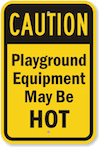Protect your child from playground burns
- Always be aware of the sun and weather conditions, and do not assume that the equipment is safe because the air temperature is not very high.
- Always check the temperature of the equipment and surfacing before letting your children play on the playground.
- Remember, a young child’s skin will burn faster than your own. If it feels hot to your hand, it may be too hot for a child’s bare skin.
- Because some materials transfer heat more slowly than others, these materials may not feel hot with a quick touch.
- Always dress your child in appropriate clothing for the playground (e.g., shoes, pants).
- Remember that playground equipment, as well as playground surfacing, may cause burns.
- Always wear shoes that stay on. Burns happen quickly on bare feet or when flip-flops fall off.
- Always watch your children while on the playground. Supervision can help to prevent some incidents.
It’s not just metal, Plastic & Rubber get hot too
You may remember the metal slides of your youth and how they could get very hot in the summer sun. But what you may not realize is that today’s newer materials, such as plastics and rubbers, also have the potential to become hot enough to burn a child’s skin.
It doesn’t have to be hot outside in order for a child to receive a burn
 The weather does not have to be hot in order for equipment to heat up and cause burns. Even in mild weather, as long as the equipment or surfacing is in direct sunlight for an extended period of time, there is a risk of sustaining a thermal burn injury. In fact, according to the CPSC one reported incident occurred on a 74°F day and resulted in a child receiving serious second‐degree burns from a plastic slide. Look for:
The weather does not have to be hot in order for equipment to heat up and cause burns. Even in mild weather, as long as the equipment or surfacing is in direct sunlight for an extended period of time, there is a risk of sustaining a thermal burn injury. In fact, according to the CPSC one reported incident occurred on a 74°F day and resulted in a child receiving serious second‐degree burns from a plastic slide. Look for:
- Uncoated metal equipment, or metal equipment where the coating has rubbed off
- Slides, swings, or other equipment that a child may sit on
- Dark‐colored plastics & rubbers, especially the surfacing under & around the playground equipment
- Asphalt & concrete surfaces near playgrounds
Children 2 years old and younger are most at risk
A child of any age can be burned by a hot surface; however, children 2 years old and younger are most at risk for two reasons:
- A young child’s skin is more susceptible to burning because it is thinner and more delicate.
- Young children have not yet learned to react by removing themselves from the hot surface. Unlike the reflex that happens when a child touches a very hot surface with their hand, a young child who is sitting or standing on the hot surface may scream from the pain of burning, but they may not know to move from the location that is burning them.
Adapted from CPSC.gov
At Halsey Schools our playgrounds are inspected regularly and children are always supervised. Our equipment is shaded. Before we go outside teachers check to make sure nothing is too hot to the touch. All teachers are trained in First Aid & CPR and preventative measures to help limit injuries.
- Happy Times August 2024 - July 25, 2024
- Learning with S’mores - July 17, 2024
- Ms. Perla - July 1, 2024




